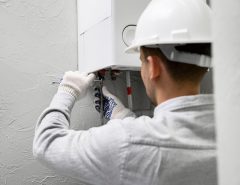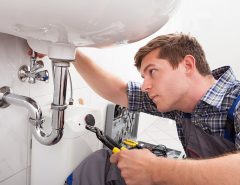A pipe inspection camera is a tool used by plumbers to find leaks or blockages in pipes. The camera can be inserted into any section of piping, sending images back to the user on a screen or monitor. It can also show temperature data if needed.
How Does a Pipe Inspection Camera Work?
You should know how a pipe inspection camera works if you need to inspect a pipe. This will help you choose the right one for your situation and ensure it is used correctly.
The entire concept of a pipe inspection camera lies in its ability to send light through the closed end of an object and capture images on the other side. The device consists of three main components: an LED light source, optics (lenses), and an image sensor chip. The image sensor chip takes all of the information from the light that comes through the optics and turns it into digital data, which can be viewed on your computer or mobile device screen.
The LED light source lends the light through the pipe, and it’s usually a small round light that can be moved around to shine on different parts of the pipe wall. The optics system consists of lenses and mirrors that help shape and direct the light before it reaches its destination.
Why Inspect Pipes with a Pipe Inspection Camera?
Using a pipe inspection camera saves you time and money by helping you catch problems before they become costly. It also helps reduce the risk of injuries, which can be expensive in terms of human life and money. If your pipes are in good condition, they will last longer and remain functional—meaning you’ll need fewer repairs down the road.
Furthermore, it lets you see inside pipes that would otherwise be impossible for humans to access. This means that if leaks or other issues with your plumbing system (whether from old age or damage caused by previous owners), you can fix them before they cause major damage to your home or business.
A pipe inspection camera can also help you catch problems with your plumbing system before they become a major issue. For example, if your toilet leaks, you can use the camera to confirm this and quickly fix it—before too much water has been wasted or damage is done. With other plumbing issues, such as leaks caused by old age or damage from previous owners, a pipe inspection camera allows you to see inside pipes that would otherwise be impossible for humans to access.
What are the Advantages of Using a Pipe Inspection Camera?
Using a pipe inspection camera is advantageous because it allows you to discover leaks and corrosion in your pipes. Leaks and pollution can cause significant downtime and cost millions of dollars, so finding them early on is essential. It’s also safer for workers because they’re not working with dangerous chemicals or equipment as they would be if they used traditional methods to find leaks/corrosion.
What kind of pipe inspection camera do I need?
The type of pipe inspection camera you need depends on the size of your pipes, andtheir material. For example, if your pipes are made from metal and are between 1/2″ and 4″, you should use a thermography camera. If your lines are underground, you’ll want to use a magnetic flux leakage (MFL) camera instead.
The best way to find out which pipe inspection camera is right for you is to speak with a professional. They can help you determine what kind of pipes they are and provide recommendations based on their findings.
Conclusion
Inspecting your pipes is a tedious and time-consuming process. However, with the help of a pipe inspection camera, you can save time and money by quickly identifying potential problems before they become significant issues.




